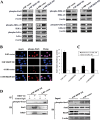Reduction of RKIP expression promotes nasopharyngeal carcinoma invasion and metastasis by activating Stat3 signaling
- PMID: 25915430
- PMCID: PMC4599279
- DOI: 10.18632/oncotarget.3847
Reduction of RKIP expression promotes nasopharyngeal carcinoma invasion and metastasis by activating Stat3 signaling
Abstract
The role and underlying mechanism of Raf kinase inhibitory protein (RKIP) in nasopharyngeal carcinoma (NPC) metastasis remain unclear. Here, we showed that RKIP was downregulated in the NPC with high metastatic potentials, and its decrement correlated with NPC metastasis and poor patient survival, and was an independent predictor for reduced overall survival. With a combination of loss-of-function and gain-of-function approaches, we observed that high expression of RKIP reduced invasion, metastasis and epithelial to mesenchymal transition (EMT) marker alternations of NPC cells. We further showed that RKIP overexpression attenuated while RKIP knockdown enhanced Stat3 phosphorylation and activation in NPC cells; RKIP reduced Stat3 phosphorylation through interacting with Stat3; Stattic attenuated NPC cell migration, invasion and EMT marker alternations induced by RKIP knockdown, whereas Stat3 overexpression restored NPC cell migration, invasion and EMT marker alternations reduced by RKIP overexpression. In addition, there was an inverse correlation between RKIP and phospho-Stat3 expression in the NPC tissues and xenograft metastases. Our data demonstrate that RKIP is a metastatic suppressor and predictor for metastasis and prognosis in NPC, and RKIP downregulation promotes NPC invasion, metastasis and EMT by activating Stat3 signaling, suggesting that RKIP/Stat3 signaling could be used as a therapeutic target for NPC metastasis.
Keywords: RKIP; Stat3; metastasis; metastatic suppressor; nasopharyngeal carcinoma.
Conflict of interest statement
The authors disclose no potential conflicts of interest.
Figures





References
-
- Lo KW, To KF, Huang DP. Focus on nasopharyngeal carcinoma. Cancer Cell. 2004;5:423–428. - PubMed
-
- Chan AT. Current treatment of nasopharyngeal carcinoma. Eur J Cancer. 2011;47:S302–S303. - PubMed
-
- Lee AW, Poon YF, Foo W, Law SC, Cheung FK, Chan DK, Tung SY, Thaw M, Ho JH. Retrospective analysis of 5037 patients with nasopharyngeal carcinoma treated during 1976-1985: overall survival and patterns of failure. Int J Radiat Oncol Biol Phys. 1992;23:261–270. - PubMed
-
- Bernier I, Tresca JP, Jollés P. Ligand-binding studies with a 23 kDa protein purified from bovine brain cytosol. Biochim Biophys Acta. 1986;871:19–23. - PubMed
-
- Yeung K, Seitz T, Li S, Janosch P, McFerran B, Kaiser C, Fee F, Katsanakis KD, Rose DW, Mischak H, Sedivy JM, Kolch W. Suppression of Raf-1 kinase activity and MAP kinase signalling by RKIP. Nature. 1999;401:173–177. - PubMed
Publication types
MeSH terms
Substances
LinkOut - more resources
Full Text Sources
Other Literature Sources
Medical
Molecular Biology Databases
Research Materials
Miscellaneous

